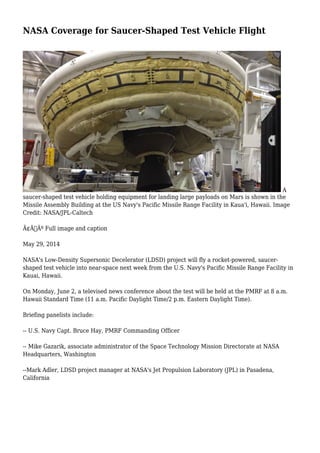
NASA Coverage for Saucer-Shaped Test Vehicle Flight
- 1. NASA Coverage for Saucer-Shaped Test Vehicle Flight A saucer-shaped test vehicle holding equipment for landing large payloads on Mars is shown in the Missile Assembly Building at the US Navy's Pacific Missile Range Facility in Kaua'i, Hawaii. Image Credit: NASA/JPL-Caltech › Full image and caption May 29, 2014 NASA's Low-Density Supersonic Decelerator (LDSD) project will fly a rocket-powered, saucer- shaped test vehicle into near-space next week from the U.S. Navy's Pacific Missile Range Facility in Kauai, Hawaii. On Monday, June 2, a televised news conference about the test will be held at the PMRF at 8 a.m. Hawaii Standard Time (11 a.m. Pacific Daylight Time/2 p.m. Eastern Daylight Time). Briefing panelists include: -- U.S. Navy Capt. Bruce Hay, PMRF Commanding Officer -- Mike Gazarik, associate administrator of the Space Technology Mission Directorate at NASA Headquarters, Washington --Mark Adler, LDSD project manager at NASA's Jet Propulsion Laboratory (JPL) in Pasadena, California
- 2. --Ian Clark, LDSD principal investigator at JPL NASA has identified six potential dates for launch of the high-altitude balloon carrying the LDSD experiment: June 3, 5, 7, 9, 11 and 14. Decisions to attempt launch of the LDSD test will be made the day before each launch opportunity date. NASA will issue launch advisories via the mission website, advisories and on Twitter at: https://twitter.com/NASA_Technology and https://twitter.com/NASA On launch attempt days, journalists are invited to PMRF to watch the liftoff and flight of the balloon carrying the LDSD. June 3 is the first launch attempt day, with a launch window extending from 8 to 9:30 a.m. HST (11 to 12:30 PDT/2 to 3:30 EDT). NASA's LDSD carries several onboard cameras. It is expected that video of selected portions, including the rocket-powered ascent, will be downlinked live and streamed live to NASA TV and online. The public may watch the news conference on June 2, and the balloon launch and subsequent test on June 3, on NASA TV or on the Web at: http://www.nasa.gov/nasatv and http://www.ustream.tv/nasajpl2 Live commentary is expected to begin at 7:45 a.m. Hawaii Standard Time (10:45 a.m. PDT/1:45 p.m. EDT). For NASA TV streaming video, downlink and updated scheduling information, visit: http://www.nasa.gov/nasatv After the balloon reaches an altitude of 120,000 feet, the rocket-powered test vehicle will be dropped. Seconds later, its motor will fire, carrying it to 180,000 feet and as fast as about Mach 3.8. More information about the LDSD space technology demonstration mission is online at: cheap first class flights http://go.usa.gov/kzZQ
- 3. NASA's Space Technology Mission Directorate funds the LDSD mission, a cooperative effort led by JPL. NASA's Marshall Space Flight Center in Huntsville, Alabama, manages LDSD within the Technology Demonstration Mission Program Office. NASA's Wallops Flight Facility in Wallops Island, Virginia, is coordinating support with the Pacific Missile Range Facility and providing the balloon systems for the LDSD test. For more information about the Space Technology Mission Directorate, visit: http://www.nasa.gov/spacetech David Steitz NASA Headquarters, Washington 202-236-5829 david.steitz@nasa.gov DC Agle Jet Propulsion Laboratory, Pasadena, Calif. 818-393-9011 agle@jpl.nasa.gov Stefan Alford Pacific Missile Range Facility, Kauai, Hawaii 808-335-4740 stefan.alford@navy.mil 2014-168